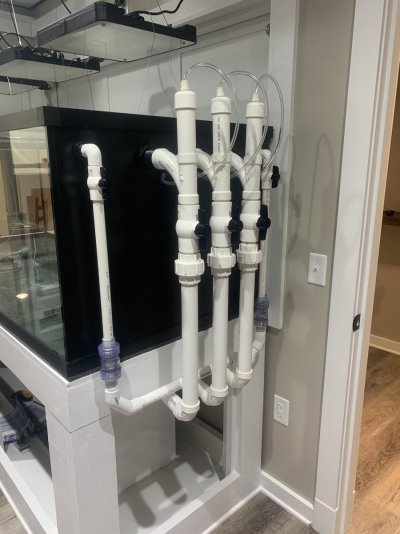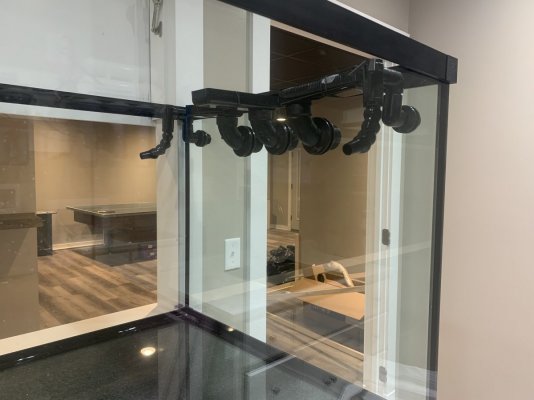I'm looking at return pumps for my upcoming first tank. One scenario that I would like very much to avoid is flooding the floor of my house. The Reef Octo Varios pumps are attractive because they come with a float valve that will cut the pump off if the sump is flooding. Seems like a great feature, but it comes at price compared to some other options. Is there a way to implement this kind of redundancy if I go with a pump without this feature? What systems do you have in place to prevent flooding? Thanks!
Navigation
Install the app
How to install the app on iOS
Follow along with the video below to see how to install our site as a web app on your home screen.
Note: This feature may not be available in some browsers.
More options
You are using an out of date browser. It may not display this or other websites correctly.
You should upgrade or use an alternative browser.
You should upgrade or use an alternative browser.
Return Pumps and Flooding
- Thread starter hannernanner
- Start date
- Tagged users None
Any mechanical preventition can and will fail. Don't use them if you want to be sure there is no failure.
The proper way to design an open system is to have enough room in your sump so that when the power is removed that the overflow height will not drain to much water into your sump.
You can see my build thread as an example of an open system designed this way. I test to ensure that the sump will not overflow by removing the power and waiting for 30 minutes. This is the only way IMO that open systems should be designed.
The proper way to design an open system is to have enough room in your sump so that when the power is removed that the overflow height will not drain to much water into your sump.
You can see my build thread as an example of an open system designed this way. I test to ensure that the sump will not overflow by removing the power and waiting for 30 minutes. This is the only way IMO that open systems should be designed.
Both good points. I will check out that build thread, I'm sure I have a lot to learn about plumbing. So I wonder why there are so many anecdotes of people flooding their floors?
Poor planning.So I wonder why there are so many anecdotes of people flooding their floors?
I agree with the above on having a sump to handle all the water volume. I also like to use check valves on the return lines as well. On my newest build I went with siphon stoppers on my returns as well. I should never ever have an overflow.
Attachments
Could siphoning cause issues independently of water volume? I've seen some folks drill a hole in the return line to break the siphon, does that serve the same purpose as those siphon stoppers?I agree with the above on having a sump to handle all the water volume. I also like to use check valves on the return lines as well. On my newest build I went with siphon stoppers on my returns as well. I should never ever have an overflow.
The right size sump. The return section should run dry before flooding. It should also be big enough to hold all the water that back flows into the sump when the pump is turned off, you should also point the nozzle toward the water surface or drill a small hole just under the water surface on the nozzle to break the siphon as a back up.
I have been thinking about this too and i saw an interesting post the other night. do you have access to a drain or somewhere you can drain to by your tank? installing an overflow drain in your sump to automagically drain in case of problems. something i am really considering.


 www.reef2reef.com
www.reef2reef.com

Adanced plumbing question - overflow from sump
I am planning a build. I have a small room/closet near where my tank will be. I am planning a custom sump and mixing station that fit this space. My question is can I put an overflow on the sump, which leads to a drain and in the same chamber as my ATO, such that I can add fresh saltwater to...
 www.reef2reef.com
www.reef2reef.com
but what about stuck open ATO's? i see that more often than none :-(Any mechanical preventition can and will fail. Don't use them if you want to be sure there is no failure.
The proper way to design an open system is to have enough room in your sump so that when the power is removed that the overflow height will not drain to much water into your sump.
You can see my build thread as an example of an open system designed this way. I test to ensure that the sump will not overflow by removing the power and waiting for 30 minutes. This is the only way IMO that open systems should be designed.
If your ATO is stuck open, and then you shut off your recirculation pump, won't you guarantee a flood? That's the problem with the concept. When your pump is running, that's when your sump level is lowest. So it seems counterintuitive to do something (like shutting off the pump) which raises the level in your sump, if your sump level is already rising. I fail to see the benefit in any circumstance. This is the exact opposite of what I would want my pump to do.but what about stuck open ATO's? i see that more often than none :-(
One option to address sump overflow in addition to designing the sump to be able to handle a power outage without causing an overflow is addressing the ATO issue Vette67 addressed. One option is a sensor in the sump that 1) turns off the ATO (cuts the power to the pump) when the sensor is triggered and 2) provides a notice to you that there is an issue so you know to investigate. Apex is one option for this and I am sure there are others as well.
oops.. quoted wrong person.. meant to quote @Vette67One option to address sump overflow in addition to designing the sump to be able to handle a power outage without causing an overflow is addressing the ATO issue Vette67 addressed. One option is a sensor in the sump that 1) turns off the ATO (cuts the power to the pump) when the sensor is triggered and 2) provides a notice to you that there is an issue so you know to investigate. Apex is one option for this and I am sure there are others as well.
i guess i was looking at it in a different aspect than the original post regarding the return pump itself. but having a redundancy of an overflow in the sump in case sensors/float valves fail is what i am looking for in my setup. multiple fail safes..
Similar threads
- Replies
- 14
- Views
- 167
- Replies
- 5
- Views
- 130


















